Biden’s Ex-Pandemic Advisor Called A Wuhan Lab Accident Plausible, But Can Writers Still Say It's “Conspiracy Theory”?
A short look back at science writers promoting a conspiracy that never was.
7 minute read
“Someday we will stop talking about the lab leak theory and maybe even admit its racist roots,” tweeted NY Times COVID reporter, Apoorva Mandavilli, during one of the tensest months of the pandemic. “But alas, that day is not yet here.”
Alas, Apoorva, that day will never be.
Almost four years into the pandemic, it’s quite clear that the media failed us with terrible reporting. Apoorva’s musing that questions about a lab accident being “racist” is just once example. Narratives guided pandemic reporting more than facts, and once science writers settled on narratives, they vigorously defended them.
Here’s one example.
Last week, President Biden’s former pandemic advisor to the National Security Council admitted at a Forbes health conference that a Chinese lab accident could have started the pandemic. “It is plausible that Covid originated in a lab accident in Wuhan…we have got to do more to keep labs safe,” said Dr. Panjabi.
Dr. Panjabi’s statement follows a report released earlier this year by the U.S. Energy Department concluding that the pandemic most likely arose from a laboratory leak. FBI chief Christopher Wray testified afterwards that his agency agrees.
But for most of the pandemic, science reporters allied with Democratic Party stalwart Anthony Fauci smeared anyone making similar statements as xenophobes or conspiracy theorists—especially if the person had any ties to the Republican Party or Donald Trump. (Question: why does party affiliation seem to guide science journalism?)
Oddly enough, some of the most incriminating evidence can be found in Anthony Fauci’s own email. Made public by Congress and freedom of information requests, these documents show that the former NIH leader knew the following by Feb. 1, 2020:
Fauci was funding Peter Daszak with the nonprofit EcoHealth Alliance to collaborate with Chinese scientists on coronavirus research in Wuhan;
Wuhan researchers were doing dangerous gain-of-function research that made viruses more deadly;
The outbreak started in Wuhan;
Daszak collaborated with and funded some of the biggest names in coronavirus research;
After examining the genetic sequence, many top virologists working with Fauci and Daszak felt that the COVID virus was not natural and may have been engineered.
While no science writer likely realized what Fauci and virologists knew and suspected back in February 2020, they also never challenged these same researchers’ public statements in their reporting. As I explained in a previous essay, science writers view themselves as assistants to the scientists they cover—voices they must amplify to ensure that the unwashed masses (that means you, reader) understand the beauty and importance of science.
In short, science writers report for, not on science.
Journalists on other beats at the Washington Post and New York Times refer to this type of journalism—with giggles and derision—as “scicomm” which is short for “science communication.”
As I began picking through COVID pandemic history, I realized that many science writers have deleted old tweets to cover up their complicity in spreading this false narrative that a Wuhan accident was a “conspiracy theory.” Nonetheless the internet never really forgets. And if we don’t look back, how can we ever learn from mistakes?
Most important, with so much nonsense flying around on social media, how can you know who to trust in the future?
A short look back at science writers promoting the “conspiracy theory” that never was.
First out of the gate promoting the “conspiracy theory” label, in February 2020: ardent scicomm writer, Amy Maxmen.
By April, New York Times science writer, Carl Zimmer, began promoting the “conspiracy” narrative—tweeting an essay by Australian virologist, Eddie Holmes. (If you take a look here, you’ll find that Holmes had actually relayed concerns some months earlier that the virus was not natural.)
"There is no evidence that SARS-CoV-2, the virus that causes COVID-19 in humans, originated in a laboratory in Wuhan, China,” Holmes wrote in the essay Zimmer promoted.
Telling the same tall tale, science writer Laurie Garrett cried out on Twitter when the government cut off a grant to Peter Daszak’s EcoHealth Alliance “based on unsupported conspiracy theories” tying the COVID virus to Daszak’s collaborators in Wuhan. (In fact, Fauci noted in a private February email that virologists were suspicious because the virus did not look natural and had emerged in Wuhan, where researchers were doing gain-of-function studies on viruses.)
Picking up the baton in May, Science Magazine’s Jon Cohen tweeted that he had looked into allegations that the Wuhan lab was linked to the pandemic’s origin, through an NIH grant Fauci provided to Peter Daszak of EcoHealth Alliance.
“Trump insists, without evidence, that a Wuhan lab is linked to the pandemic’s origin,” Cohen posted. (Again, see what Fauci’s emails to find what he knew to the contrary months prior.)
A few days later, science writer Amy Maxmen posted a National Geographic story with Fauci opining on “the conspiracy theory that coronavirus was made in a Chinese lab” tagging the story’s authors, Nsikan Akpan and Victoria Jaggard. (If you look ahead to late 2021, Maxmen does a 180 and denies promoting the “conspiracy theory” label. I’m not joking.)
By May, the BBC’s Roland Pease tweeted that he had interviewed several virologists including EcoHealth Alliance’s Peter Daszak “to try to rebut nonsense conspiracy narratives about the origin” of COVID.
“This is a delicious debunking by the Daily Beast about U.S. military contractors report alleging COVID-19 escape from Wuhan lab,” Science Magazine’s Cohen posted, a couple weeks later. (To see a delicious debunking of Cohen’s own reporting, see Fauci’s emails here.)
That July, the BBC’s Pease came out swinging (once again!) this time against State Department cables that the Washington Post reported “warned of safety issues at Wuhan lab studying bat coronaviruses.”
Interviewing Peter Daszak (once again!) Pease posted, “A key component of the Wuhan Labs conspiracy idea falls apart.”
A few days later, Science Magazine’s Cohen platformed Shi Zhengli of the Wuhan Institute of Virology to speak out against allegations that the pandemic started in her lab. “She’d like an apology from Trump,” Cohen reported.
Science writer Laurie Garrett then boosted another Cohen Science article claiming there was no evidence linking the pandemic to a Wuhan lab. According to Garrett, Trump was not only wrong to insist that the virus came out of a Wuhan lab, Trump endangered the research of Peter Daszak’s EcoHealth Alliance and could lead us to another pandemic.
Closing out 2020, New York Times’ Carl Zimmer wrote a laudatory article in Time Magazine, praising the Wuhan Institute of Virology’s Shi Zhengli for “scientific accomplishments.”
“The Trump Administration has attacked Shi’s institute, insinuating that it is responsible for the pandemic,” Zimmer wrote, in Time. “The charge is not just baseless but dangerous.”
Picking up after the New Year, science writer Jane Qiu boosted a Nature Medicine essay by virologist Angela Rasmussen who argued that objective investigations in the Wuhan lab “have been derailed by politics and conspiracy theories.” (As previously reported, Jane Qiu has written a series of articles in multiple outlets to defend Wuhan’s Shi Zhengli and downplay the possibility of a lab accident.)
Despite a year’s worth of clamoring that a Wuhan lab accident was a “conspiracy theory,” some of the stuffing began coming out of the narrative in March 2021. In a CNN documentary, the former director of the US Centers for Disease Control and Prevention (CDC) said he believed the pandemic began in Wuhan lab.
Not to worry, Scientific American’s Laura Helmuth rides to the rescue!
Without bothering to do any reporting, Helmuth hopped on Twitter to knock down CNN’s report as a “conspiracy theory” while thanking virologists for their “debunking.” Helmuth then notified other science writers that they had to “get the science right.”
Tasked to “get the science right,” Scientific American’s Josh Fischman then tried picking apart the former CDC Director’s claims with a long, tortuous thinky-piece, no doubt edited by his boss, Laura Helmuth: “Former CDC director Robert Redfield says he believes in a lab leak—but offers no evidence.”
By May 2021, Nsikan Akpan was back on his game. Remember, during May 2020, Amy Maxmen tweeted Akpen’s National Geographic story that quoted Fauci opining against “the conspiracy theory that coronavirus was made in a Chinese lab.” Now the health and science editor at New York Public Radio, Akpen tweeted that claims of a Wuhan lab accident should now be considered “climate change denial.”
But here comes Amy Maxmen, again.
In June 2021, Anthony Fauci’s emails began leaking to the press, and dismissing them as a “conspiracy theory” began wearing thin. Not to worry, Maxmen floated a new storyline. Although she had been promoting the “conspiracy theory” narrative since the pandemic’s outbreak, she now tried a reversal: a lab accident was always possible.
“The media is fabricating a plot-twist narrative that scientists & the media thought a lab leak was impossible,” Maxmen tweeted. “As Fauci tells WSJ: ‘That is an accusation that I have to tell you, is preposterous.”
By December 2021, Maxmen’s 180, against the “conspiracy theory” narrative became a 360. To any normal person, this would cause a bad case of vertigo, but Maxmen spun right back to promoting the “conspiracy theory” narrative—this time with an article in the New Republic.
Even science writers in Canada joined the fun.
After two virologists dismissed evidence of a possible lab accident as a “conspiracy” in Foreign Policy, The Globe and Mail’s Andre Picard gave them a signal boost. “Conspiracy theories about COVID19 are dangerous and unsupported,” Picard tweeted. “There are too many embracing the ‘lab leak’ theory without any evidence.”
I think it’s time to cut this short.
To be clear, this is not an exhaustive look at the role science writers played in promoting a fake narrative, shouting down evidence that the pandemic could have started in a Wuhan lab as a “conspiracy theory.” But this brief glimpse into history should guide readers to who they can trust in the future.




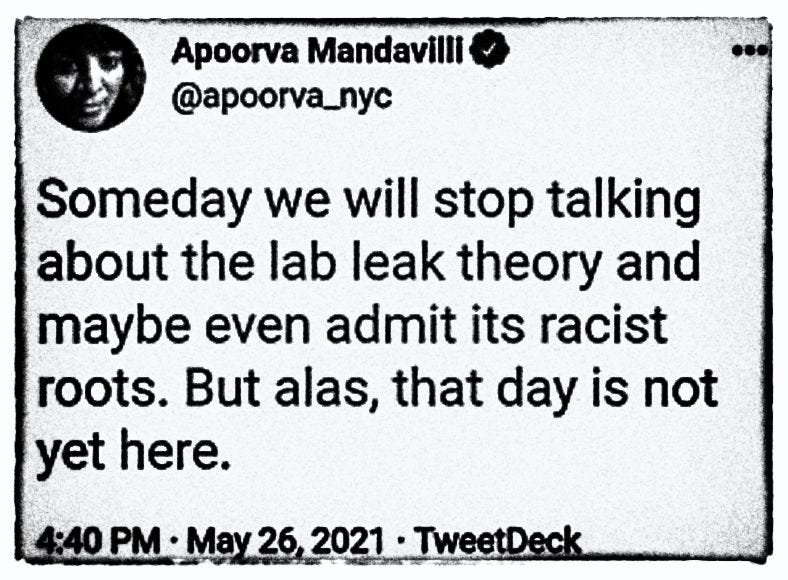
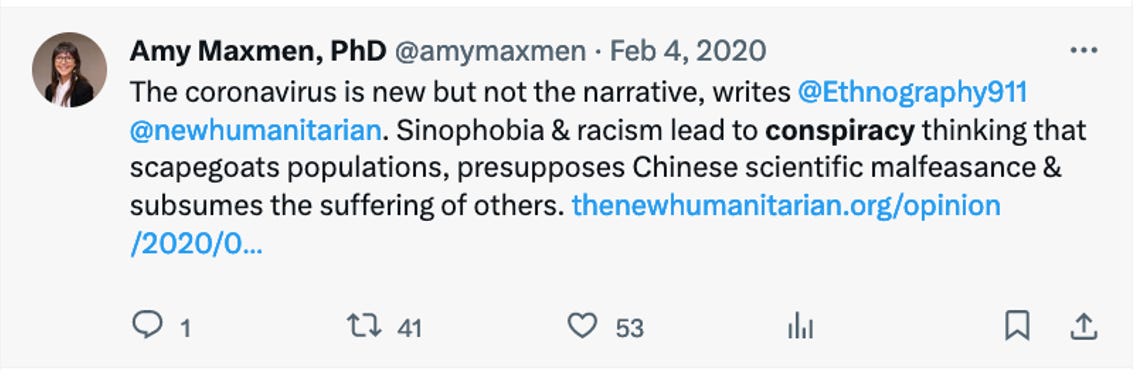





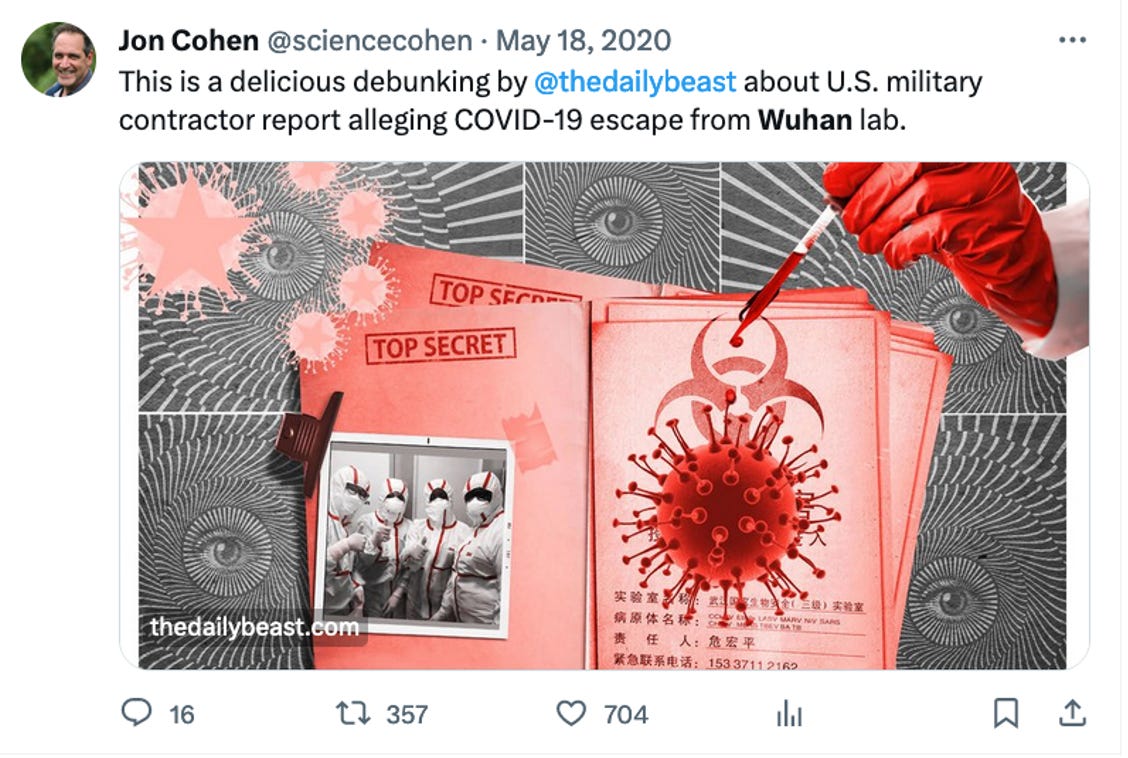




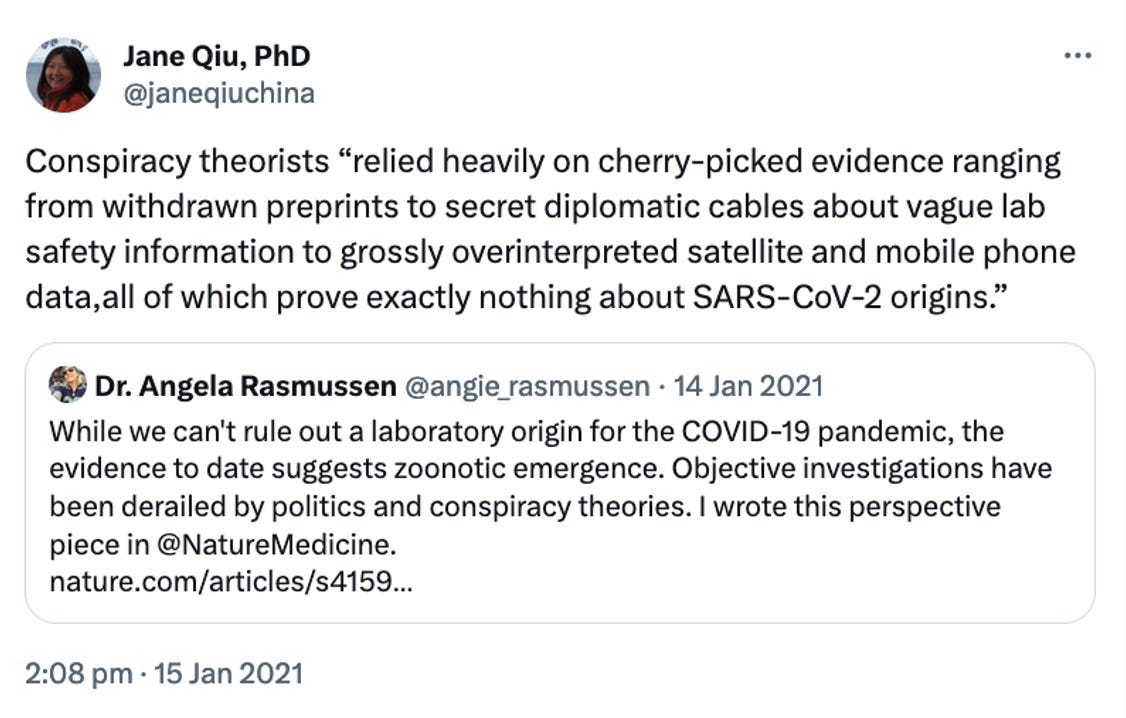
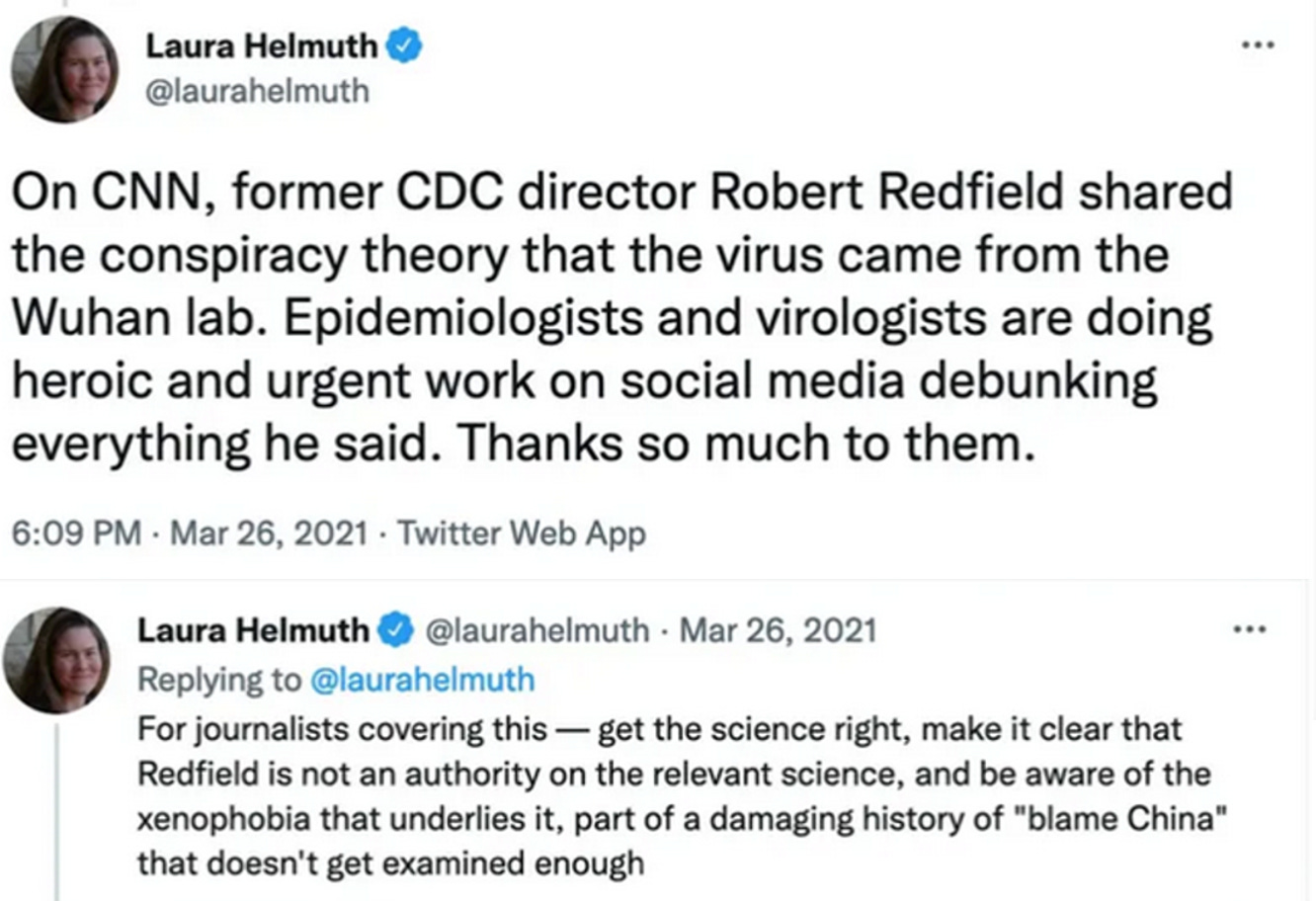
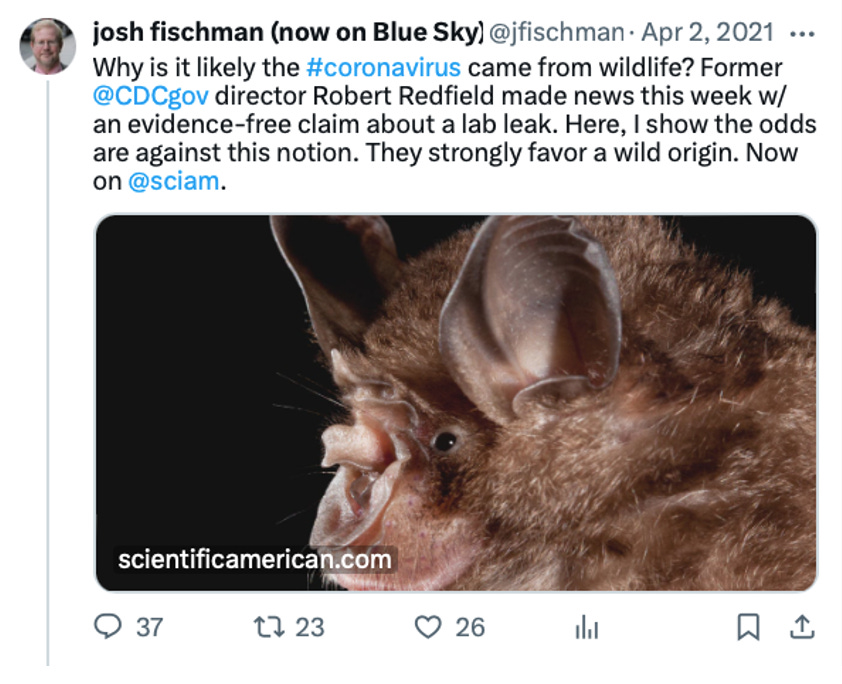
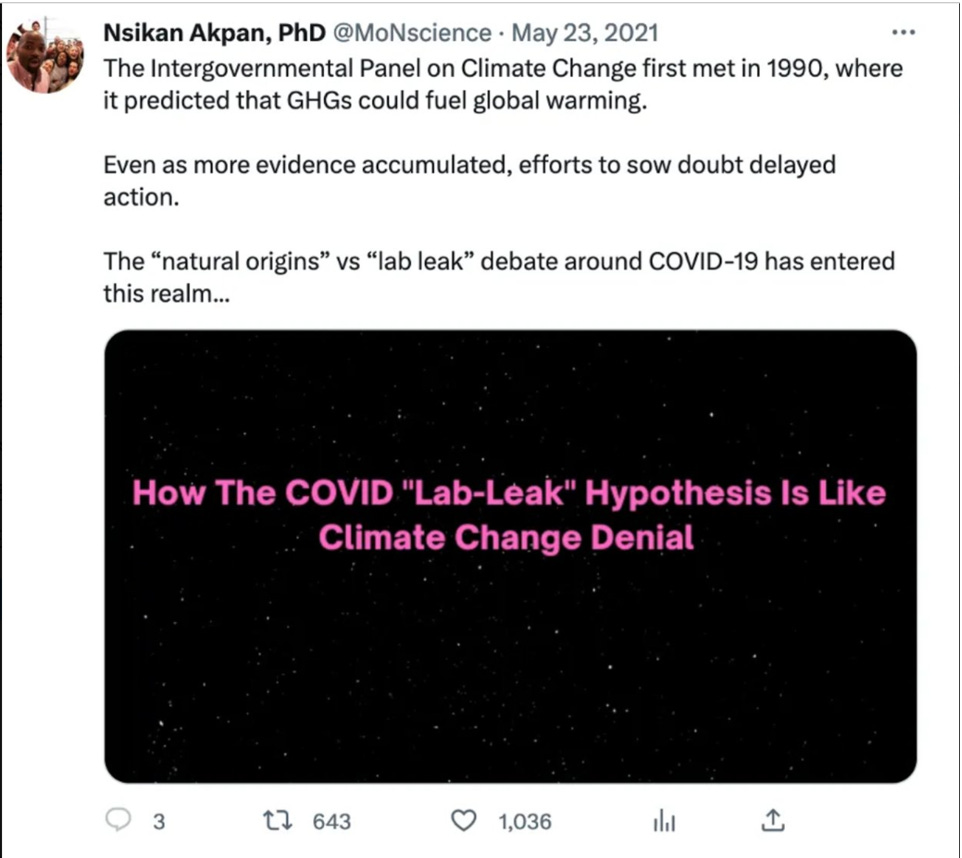



Obviously the gain of function labs operate under secrecy. Why? Secrecy occurs to hide something. What is the source of funding? Are there tax dollars involved? There’s so much hidden from us, we are merely pawns in some sort of game of life.
It's really strange you have this blog about covering the origins of the pandemic honestly and scientifically, and yet you've never acknowledged the first peer-reviewed article to examine a lab origin at all:
https://www.ncbi.nlm.nih.gov/pmc/articles/PMC7435492/
Or it's addendum, which is the very first paper to definitively show that the H1N1 virus of 1977 was in fact engineered, in its case by serial passage:
https://onlinelibrary.wiley.com/doi/10.1002/bies.202100017
Why have you never once cited or referenced either of those papers? And why do you refuse to discuss this pandemic's origins as a reverting LAV, which has widely been suspected as the source of the 1977 global outbreak, and is clearly the source of the global outbreak of OPV that's been worsening with every passing year:
https://harvard2thebighouse.substack.com/p/understanding-covid-19-and-seasonal
You seem to be very good at throwing stones, try looking the mirror instead.